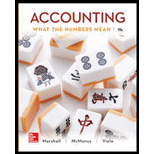
Concept Introduction:
Liquidity Measures:
The set of ratios that measures the ability of the company to pay off its short-term debts or obligations by comparing the assets that can be easily convertible into cash or liquid assets with its short-term liabilities refers to liquidity measurement ratios.
Requirement a:
To calculate:
The working capital from the given data reported in the
Answer to Problem 11.1ME
| Current Assets: | Amount in $ | Amount in $ |
| Cash | 16,000 | |
| 44,000 | ||
| Merchandise inventory | 60,000 | |
| Total Current Assets (A) | 120,000 | |
| Current Liabilities: | ||
| Wages payable | 10,000 | |
| Accounts payable | 30,000 | |
| Total Current Liabilities (B) | 40,000 | |
| Net working capital (A-B) | 80,000 |
Explanation of Solution
The working capital is computed by using the formula:
Current Assets=
Current Assets=
Total Current Assets=
Current Liabilities=
Total Current Liabilities=
Therefore using the above formula, working capital is:
Working Capital=
Working Capital at December 31st, 2016=
Concept Introduction:
Liquidity Measures:
The set of ratios that measures the ability of the company to pay off its short-term debts or obligations by comparing the assets that can be easily convertible into cash or liquid assets with its short-term liabilities refers to liquidity measurement ratios. Current ratio, acid-test ratio, working capital are the most used liquidity ratios in the business.
Requirement b:
To calculate:
The current ratio from the given balance sheet report to measure the liquidity of the company.
Answer to Problem 11.1ME
| Current Assets: | Amount in $ | Amount in $ |
| Cash | 16,000 | |
| Accounts receivables | 44,000 | |
| Merchandise inventory | 60,000 | |
| Total Current Assets (A) | 120,000 | |
| Current Liabilities: | ||
| Wages payable | 10,000 | |
| Accounts payable | 30,000 | |
| Total Current Liabilities (B) | 40,000 | |
| Current Ratio (A/B) | 3 |
Explanation of Solution
The formula for computing current ratio is:
Current Assets=
Total Current Assets=
Current Liabilities=
Total Current Liabilities=
Therefore using the above formula, current ratio is:
Current Ratio =
Current Ratio at December 31st, 2016=
Concept Introduction:
Liquidity Measures:
The set of ratios that measures the ability of the company to pay off its short-term debts or obligations by comparing the assets that can be easily convertible into cash or liquid assets with its short-term liabilities refers to liquidity measurement ratios. Current ratio, acid-test ratio, working capital are the most used liquidity ratios in the business.
Requirement c:
To calculate:
The acid-test ratio from the given balance sheet report to measure the ability of the company to pay its current liabilities with its quick assets.
Answer to Problem 11.1ME
| Current Assets: | Amount in $ | Amount in $ |
| Cash | 16,000 | |
| Accounts receivables | 44,000 | |
| Total Quick Assets (A) | 60,000 | |
| Current Liabilities: | ||
| Wages payable | 10,000 | |
| Accounts payable | 30,000 | |
| Total Current Liabilities (B) | 40,000 | |
| Acid-test Ratio (A/B) | 1.5 |
Explanation of Solution
The formula for calculating acid-test ratio is:
Therefore using the above formula, acid-test ratio is:
Acid-test Ratio at December 31st, 2016=
Note: Inventory is excluded in acid-test ratio for the reason that it might not turn to cash quickly.
Want to see more full solutions like this?
Chapter 11 Solutions
Accounting: What the Numbers Mean
- Alicia Logistics purchased a conveyor belt system for its distribution center at a cost of $105,800. The system has an estimated residual value of $8,600 and an estimated useful life of 12 years. What is the amount of the annual depreciation computed by the straight-line method?arrow_forwardI am looking for help with this general accounting question using proper accounting standards.arrow_forwardFinancial accountingarrow_forward
- Please help me solve this general accounting problem with the correct financial process.arrow_forwardMCQarrow_forwardNirvana Technologies has $85,000 in assets. They also have $32,000 in liabilities and $8,500 in expenses, and they paid out $10,000 in dividends this year. The extended accounting equation is assets = liabilities + (revenue - (expenses + dividends)). What would their revenue need to be for their accounts to be in balance?arrow_forward

 AccountingAccountingISBN:9781337272094Author:WARREN, Carl S., Reeve, James M., Duchac, Jonathan E.Publisher:Cengage Learning,
AccountingAccountingISBN:9781337272094Author:WARREN, Carl S., Reeve, James M., Duchac, Jonathan E.Publisher:Cengage Learning, Accounting Information SystemsAccountingISBN:9781337619202Author:Hall, James A.Publisher:Cengage Learning,
Accounting Information SystemsAccountingISBN:9781337619202Author:Hall, James A.Publisher:Cengage Learning, Horngren's Cost Accounting: A Managerial Emphasis...AccountingISBN:9780134475585Author:Srikant M. Datar, Madhav V. RajanPublisher:PEARSON
Horngren's Cost Accounting: A Managerial Emphasis...AccountingISBN:9780134475585Author:Srikant M. Datar, Madhav V. RajanPublisher:PEARSON Intermediate AccountingAccountingISBN:9781259722660Author:J. David Spiceland, Mark W. Nelson, Wayne M ThomasPublisher:McGraw-Hill Education
Intermediate AccountingAccountingISBN:9781259722660Author:J. David Spiceland, Mark W. Nelson, Wayne M ThomasPublisher:McGraw-Hill Education Financial and Managerial AccountingAccountingISBN:9781259726705Author:John J Wild, Ken W. Shaw, Barbara Chiappetta Fundamental Accounting PrinciplesPublisher:McGraw-Hill Education
Financial and Managerial AccountingAccountingISBN:9781259726705Author:John J Wild, Ken W. Shaw, Barbara Chiappetta Fundamental Accounting PrinciplesPublisher:McGraw-Hill Education





